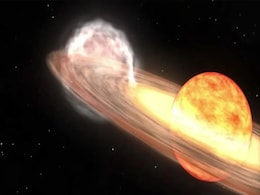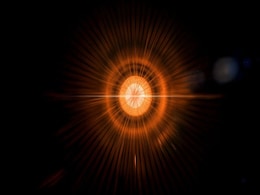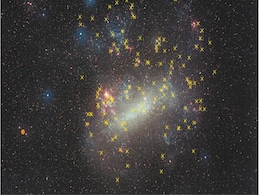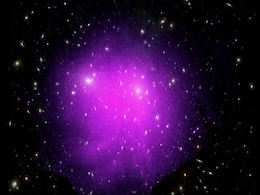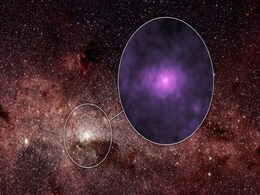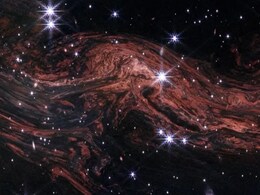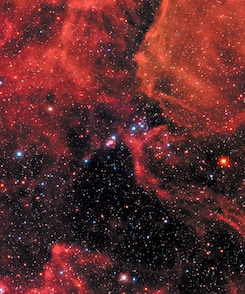Supernova
- All
- News
- Videos
- Web Stories
-

Signs Of A Supermassive Black Hole Hiding In Nearby Spiral Galaxy
- Friday April 18, 2025
- World News | Edited by NDTV News Desk
Webb witnessed a highly ionised gas whose level of energy was too high to come from something like supernovae, making scientists believe the presence of a supermassive black hole.
-
 www.ndtv.com
www.ndtv.com
-

First Future Type 1a Supernova Detected: White Dwarf Pair to Collide in 23 Billion Years
- Tuesday April 8, 2025
- Written by Gadgets 360 Staff
Astronomers have discovered a pair of white dwarf stars located about 150 light-years from Earth that are on course to collide and produce a Type 1a supernova in approximately 23 billion years. This is the first such system identified near our region of the galaxy. With a combined mass of 1.56 solar masses, the stars are slowly spiralling toward ea...
-
 www.gadgets360.com
www.gadgets360.com
-

T Corona Borealis May Erupt Soon: Rare Nova Could Be Visible to Naked Eye
- Tuesday April 1, 2025
- Written by Gadgets 360 Staff
T Corona Borealis, a binary star system in the Northern Crown constellation, is showing signs of an imminent nova eruption. The white dwarf star, which pulls material from its red giant companion, last erupted in 1946. Astronomers have detected patterns similar to previous eruptions, leading to predictions of a possible outburst within the next two...
-
 www.gadgets360.com
www.gadgets360.com
-

Supernova Remnants Found in Oceanic Samples, Scientists Look to Moon
- Wednesday March 26, 2025
- Written by Gadgets 360 Staff
Scientists have identified supernova debris in deep-sea sediments, including a rare plutonium isotope linked to a kilonova. Researchers believe a neutron star collision occurred nearly 10 million years ago, scattering radioactive material across space. To validate this theory, they plan to analyze lunar soil, which remains undisturbed by Earth's ge...
-
 www.gadgets360.com
www.gadgets360.com
-

Wolf-Rayet 104's Orbit Tilt Reduces Gamma-Ray Burst Threat, Study Finds
- Thursday March 20, 2025
- Written by Gadgets 360 Staff
New research using Keck Observatory’s instruments confirms that the orbit of Wolf-Rayet 104 is tilted 30-40 degrees away from Earth, lowering concerns about a possible gamma-ray burst. Previously, it was believed that the system’s alignment could pose a risk. However, spectroscopy data now challenges these assumptions, raising new questions abo...
-
 www.gadgets360.com
www.gadgets360.com
-

Water May Have Formed in the Universe 100 Million Years After Big Bang
- Thursday March 13, 2025
- Written by Gadgets 360 Staff
A new study suggests water formed in the universe just 100–200 million years after the Big Bang, much earlier than previously estimated. Researchers examined ancient supernovas to understand how oxygen combined with hydrogen to create water. If confirmed, these findings could change perspectives on when the conditions for life first emerged. The ...
-
 www.gadgets360.com
www.gadgets360.com
-

Scientists Detects Most Energetic Neutrino Ever in the Mediterranean Sea
- Friday February 14, 2025
- Written by Gadgets 360 Staff
A record-breaking neutrino with 220 quadrillion electron volts has been detected in the Mediterranean Sea. Captured by the KM3NeT deep-sea telescope, this rare cosmic event could be linked to powerful astrophysical phenomena such as black holes or supernovae. Neutrinos, nearly massless particles that rarely interact with matter, provide crucial ins...
-
 www.gadgets360.com
www.gadgets360.com
-

Scientists Discover Two New Supernova Remnants in a Surprising Location
- Thursday February 13, 2025
- Written by Gadgets 360 Staff
Two previously unknown supernova remnants, J0624-6948 and J0614-7251, have been detected in the outskirts of the Large Magellanic Cloud. Their unexpected location suggests a higher-than-expected concentration of ionised gas, raising new questions about galactic evolution. Scientists propose that gravitational interactions between the Milky Way and ...
-
 www.gadgets360.com
www.gadgets360.com
-

Hubble Spots Distant Supernova in Gemini, Enhancing Cosmic Distance Studies
- Tuesday February 4, 2025
- Written by Gadgets 360 Staff
The NASA/ESA Hubble Space Telescope has captured a stunning image of SN 2022aajn, a Type Ia supernova in the constellation Gemini. Located 600 million light-years away, the explosion was first detected in November 2022. Type Ia supernovae serve as essential cosmic distance markers due to their predictable brightness. Hubble’s observations, part o...
-
 www.gadgets360.com
www.gadgets360.com
-

Vera C. Rubin Observatory to Detect Millions of Exploding Stars
- Wednesday January 29, 2025
- Written by Gadgets 360 Staff
The Vera C. Rubin Observatory, set to begin its 10-year Legacy Survey of Space and Time (LSST) later this year, will track millions of Type Ia supernovae to advance our understanding of dark energy. These supernovae, resulting from white dwarf stars in binary systems, will be studied in detail to provide crucial data on the universe’s acceleratin...
-
 www.gadgets360.com
www.gadgets360.com
-

Early Supernovas Could Have Created Water in the Universe, Paving the Way for Life 100 Million Years Post-Big Bang
- Friday January 24, 2025
- Written by Gadgets 360 Staff
A recent study suggests that supernova explosions, triggered by the death of early stars, could have created significant amounts of water just 100 million years after the Big Bang. Simulations of these early, massive stars show that their explosive deaths may have resulted in the formation of water molecules within the dense hydrogen and oxygen clo...
-
 www.gadgets360.com
www.gadgets360.com
-

Coma Cluster’s Distance Closer Than Predicted, Amplifying Hubble Tension Crisis
- Friday January 24, 2025
- Written by Gadgets 360 Staff
A new study led by Dan Scolnic and Adam Riess reveals that the Coma Cluster is 38 million light-years closer than predicted by standard cosmological models, intensifying the ongoing Hubble tension. This discrepancy, involving measurements of type Ia supernova explosions, challenges the universe's expansion rate as predicted by the Hubble–Lemaîtr...
-
 www.gadgets360.com
www.gadgets360.com
-

Meta Plans Oakley-Branded Glasses, Explores Watches and Earbuds
- Wednesday January 22, 2025
- Mark Gurman, Bloomberg
Meta is working on upgrade its popular smart glasses and is exploring new wearable devices such as watches and camera-equipped earbuds. Meta’s devices group, Reality Labs, also plans to release new high-end glasses with a built-in display in 2025.
-
 www.gadgets360.com
www.gadgets360.com
-

Zombie Star’s Mysterious Spiky Filaments Baffle Astronomers in New Discovery
- Thursday January 23, 2025
- Written by Gadgets 360 Staff
A zombie star remnant, Pa 30, located 6,500 light-years from Earth, is surrounded by spiky filaments that have baffled astronomers. These filaments, observed for centuries, continue to puzzle scientists, as their formation and long-term stability remain unclear. The star's explosion in 1181 was initially noted by skywatchers, but its remnant struct...
-
 www.gadgets360.com
www.gadgets360.com
-

James Webb Space Telescope Unveils Hidden Interstellar Wonders of Supernova Cassiopeia A
- Friday January 17, 2025
- Written by Gadgets 360 Staff
The James Webb Space Telescope has provided a rare glimpse into the remnants of a centuries-old supernova in Cassiopeia A. Using infrared technology, the telescope captured a light echo caused by a massive star’s explosion, unveiling new insights into the interstellar medium and its magnetic structures. This breakthrough discovery offers valuable...
-
 www.gadgets360.com
www.gadgets360.com
-

Signs Of A Supermassive Black Hole Hiding In Nearby Spiral Galaxy
- Friday April 18, 2025
- World News | Edited by NDTV News Desk
Webb witnessed a highly ionised gas whose level of energy was too high to come from something like supernovae, making scientists believe the presence of a supermassive black hole.
-
 www.ndtv.com
www.ndtv.com
-

First Future Type 1a Supernova Detected: White Dwarf Pair to Collide in 23 Billion Years
- Tuesday April 8, 2025
- Written by Gadgets 360 Staff
Astronomers have discovered a pair of white dwarf stars located about 150 light-years from Earth that are on course to collide and produce a Type 1a supernova in approximately 23 billion years. This is the first such system identified near our region of the galaxy. With a combined mass of 1.56 solar masses, the stars are slowly spiralling toward ea...
-
 www.gadgets360.com
www.gadgets360.com
-

T Corona Borealis May Erupt Soon: Rare Nova Could Be Visible to Naked Eye
- Tuesday April 1, 2025
- Written by Gadgets 360 Staff
T Corona Borealis, a binary star system in the Northern Crown constellation, is showing signs of an imminent nova eruption. The white dwarf star, which pulls material from its red giant companion, last erupted in 1946. Astronomers have detected patterns similar to previous eruptions, leading to predictions of a possible outburst within the next two...
-
 www.gadgets360.com
www.gadgets360.com
-

Supernova Remnants Found in Oceanic Samples, Scientists Look to Moon
- Wednesday March 26, 2025
- Written by Gadgets 360 Staff
Scientists have identified supernova debris in deep-sea sediments, including a rare plutonium isotope linked to a kilonova. Researchers believe a neutron star collision occurred nearly 10 million years ago, scattering radioactive material across space. To validate this theory, they plan to analyze lunar soil, which remains undisturbed by Earth's ge...
-
 www.gadgets360.com
www.gadgets360.com
-

Wolf-Rayet 104's Orbit Tilt Reduces Gamma-Ray Burst Threat, Study Finds
- Thursday March 20, 2025
- Written by Gadgets 360 Staff
New research using Keck Observatory’s instruments confirms that the orbit of Wolf-Rayet 104 is tilted 30-40 degrees away from Earth, lowering concerns about a possible gamma-ray burst. Previously, it was believed that the system’s alignment could pose a risk. However, spectroscopy data now challenges these assumptions, raising new questions abo...
-
 www.gadgets360.com
www.gadgets360.com
-

Water May Have Formed in the Universe 100 Million Years After Big Bang
- Thursday March 13, 2025
- Written by Gadgets 360 Staff
A new study suggests water formed in the universe just 100–200 million years after the Big Bang, much earlier than previously estimated. Researchers examined ancient supernovas to understand how oxygen combined with hydrogen to create water. If confirmed, these findings could change perspectives on when the conditions for life first emerged. The ...
-
 www.gadgets360.com
www.gadgets360.com
-

Scientists Detects Most Energetic Neutrino Ever in the Mediterranean Sea
- Friday February 14, 2025
- Written by Gadgets 360 Staff
A record-breaking neutrino with 220 quadrillion electron volts has been detected in the Mediterranean Sea. Captured by the KM3NeT deep-sea telescope, this rare cosmic event could be linked to powerful astrophysical phenomena such as black holes or supernovae. Neutrinos, nearly massless particles that rarely interact with matter, provide crucial ins...
-
 www.gadgets360.com
www.gadgets360.com
-

Scientists Discover Two New Supernova Remnants in a Surprising Location
- Thursday February 13, 2025
- Written by Gadgets 360 Staff
Two previously unknown supernova remnants, J0624-6948 and J0614-7251, have been detected in the outskirts of the Large Magellanic Cloud. Their unexpected location suggests a higher-than-expected concentration of ionised gas, raising new questions about galactic evolution. Scientists propose that gravitational interactions between the Milky Way and ...
-
 www.gadgets360.com
www.gadgets360.com
-

Hubble Spots Distant Supernova in Gemini, Enhancing Cosmic Distance Studies
- Tuesday February 4, 2025
- Written by Gadgets 360 Staff
The NASA/ESA Hubble Space Telescope has captured a stunning image of SN 2022aajn, a Type Ia supernova in the constellation Gemini. Located 600 million light-years away, the explosion was first detected in November 2022. Type Ia supernovae serve as essential cosmic distance markers due to their predictable brightness. Hubble’s observations, part o...
-
 www.gadgets360.com
www.gadgets360.com
-

Vera C. Rubin Observatory to Detect Millions of Exploding Stars
- Wednesday January 29, 2025
- Written by Gadgets 360 Staff
The Vera C. Rubin Observatory, set to begin its 10-year Legacy Survey of Space and Time (LSST) later this year, will track millions of Type Ia supernovae to advance our understanding of dark energy. These supernovae, resulting from white dwarf stars in binary systems, will be studied in detail to provide crucial data on the universe’s acceleratin...
-
 www.gadgets360.com
www.gadgets360.com
-

Early Supernovas Could Have Created Water in the Universe, Paving the Way for Life 100 Million Years Post-Big Bang
- Friday January 24, 2025
- Written by Gadgets 360 Staff
A recent study suggests that supernova explosions, triggered by the death of early stars, could have created significant amounts of water just 100 million years after the Big Bang. Simulations of these early, massive stars show that their explosive deaths may have resulted in the formation of water molecules within the dense hydrogen and oxygen clo...
-
 www.gadgets360.com
www.gadgets360.com
-

Coma Cluster’s Distance Closer Than Predicted, Amplifying Hubble Tension Crisis
- Friday January 24, 2025
- Written by Gadgets 360 Staff
A new study led by Dan Scolnic and Adam Riess reveals that the Coma Cluster is 38 million light-years closer than predicted by standard cosmological models, intensifying the ongoing Hubble tension. This discrepancy, involving measurements of type Ia supernova explosions, challenges the universe's expansion rate as predicted by the Hubble–Lemaîtr...
-
 www.gadgets360.com
www.gadgets360.com
-

Meta Plans Oakley-Branded Glasses, Explores Watches and Earbuds
- Wednesday January 22, 2025
- Mark Gurman, Bloomberg
Meta is working on upgrade its popular smart glasses and is exploring new wearable devices such as watches and camera-equipped earbuds. Meta’s devices group, Reality Labs, also plans to release new high-end glasses with a built-in display in 2025.
-
 www.gadgets360.com
www.gadgets360.com
-

Zombie Star’s Mysterious Spiky Filaments Baffle Astronomers in New Discovery
- Thursday January 23, 2025
- Written by Gadgets 360 Staff
A zombie star remnant, Pa 30, located 6,500 light-years from Earth, is surrounded by spiky filaments that have baffled astronomers. These filaments, observed for centuries, continue to puzzle scientists, as their formation and long-term stability remain unclear. The star's explosion in 1181 was initially noted by skywatchers, but its remnant struct...
-
 www.gadgets360.com
www.gadgets360.com
-

James Webb Space Telescope Unveils Hidden Interstellar Wonders of Supernova Cassiopeia A
- Friday January 17, 2025
- Written by Gadgets 360 Staff
The James Webb Space Telescope has provided a rare glimpse into the remnants of a centuries-old supernova in Cassiopeia A. Using infrared technology, the telescope captured a light echo caused by a massive star’s explosion, unveiling new insights into the interstellar medium and its magnetic structures. This breakthrough discovery offers valuable...
-
 www.gadgets360.com
www.gadgets360.com



